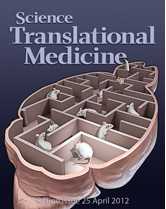Sci Transl Med:化合物治疗小鼠的自闭症行为
2012-04-27 EurekAlert! EurekAlert!
4月25日,国际著名杂志Science Translational Medicine在线刊登了国外研究人员的最新研究成果“Negative Allosteric Modulation of the mGluR5 Receptor Reduces Repetitive Behaviors and Rescues Social Deficits in Mouse Models of Autism,”,
4月25日,国际著名杂志Science Translational Medicine在线刊登了国外研究人员的最新研究成果“Negative Allosteric Modulation of the mGluR5 Receptor Reduces Repetitive Behaviors and Rescues Social Deficits in Mouse Models of Autism,”,文章中,研究者揭示了化合物治疗小鼠的自闭症的行为。
一种以谷氨酸——这是脑中的一种化学物质——作用为标靶的药物可减少小鼠的重复行为并可部分逆转其社交能力的欠缺——这是自闭症中的2个核心症状。由于数种抑制谷氨酸的化合物已经在包括脆性X综合征等人类的其它疾病的临床试验中使用,因此这些化合物在自闭症患者中进行测试是可行的。在哺乳动物中,含有谷氨酸的神经元控制着重复性的行为及社会行为。
GRN-529是一种调控脑中谷氨酸如何释放的化合物。它是通过mGluR5受体作用的。Jill Silverman及其同事们在用一种特别的近交系小鼠的试验中测试了GRN-529的作用。与其它的小鼠自闭症模型不同,这些小鼠显示出独特的自闭症样的行为,其中包括不寻常的社交互动、受到损害的沟通模式及重复性的自我梳理。该小组将这种化合物注射到这些小鼠的脑中并发现,这种治疗减少了其重复性的行为并部分地逆转了这些动物的明显的社交能力的欠缺。该治疗不能改善小鼠的受到损害的沟通,提示mGluR5受体可能没有参与这一复杂的行为作业。该小组在2个不同的机构中所做的2个独立的小鼠试验中复制了GRN-529的有益的功效。
这些结果支持在罹患自闭症的人中开展测试谷氨酸抑制药物功效的临床试验。然而,正如一则相关的《焦点》文章所指出的,有许多原因可以解释为什么一种药物在动物中有效但却在人体中无效,也有许多的原因可以解释为什么一种药物显示了早期的临床前景但以后却不能有效地治疗一种疾病。考虑到这些告诫,文章的作者对自闭症的药物治疗将出现于这一研究及未来的研究保持着审慎的乐观态度。

doi:10.1126/scitranslmed.3003501
PMC:
PMID:
Negative Allosteric Modulation of the mGluR5 Receptor Reduces Repetitive Behaviors and Rescues Social Deficits in Mouse Models of Autism
Jill L. Silverman1, Daniel G. Smith2, Stacey J. Sukoff Rizzo2, Michael N. Karras1, Sarah M. Turner1, Seda S. Tolu1, Dianne K. Bryce2, Deborah L. Smith2, Kari Fonseca2, Robert H. Ring2,* and Jacqueline N. Crawley1,†
Neurodevelopmental disorders such as autism and fragile X syndrome were long thought to be medically untreatable, on the assumption that brain dysfunctions were immutably hardwired before diagnosis. Recent revelations that many cases of autism are caused by mutations in genes that control the ongoing formation and maturation of synapses have challenged this dogma. Antagonists of metabotropic glutamate receptor subtype 5 (mGluR5), which modulate excitatory neurotransmission, are in clinical trials for fragile X syndrome, a major genetic cause of intellectual disabilities. About 30% of patients with fragile X syndrome meet the diagnostic criteria for autism. Reasoning by analogy, we considered the mGluR5 receptor as a potential target for intervention in autism. We used BTBR T+tf/J (BTBR) mice, an established model with robust behavioral phenotypes relevant to the three diagnostic behavioral symptoms of autism—unusual social interactions, impaired communication, and repetitive behaviors—to probe the efficacy of a selective negative allosteric modulator of the mGluR5 receptor, GRN-529. GRN-529 reduced repetitive behaviors in three cohorts of BTBR mice at doses that did not induce sedation in control assays of open field locomotion. In addition, the same nonsedating doses reduced the spontaneous stereotyped jumping that characterizes a second inbred strain of mice, C58/J. Further, GRN-529 partially reversed the striking lack of sociability in BTBR mice on some parameters of social approach and reciprocal social interactions. These findings raise the possibility that a single targeted pharmacological intervention may alleviate multiple diagnostic behavioral symptoms of autism.
作者:EurekAlert!
版权声明:
本网站所有注明“来源:梅斯医学”或“来源:MedSci原创”的文字、图片和音视频资料,版权均属于梅斯医学所有。非经授权,任何媒体、网站或个人不得转载,授权转载时须注明“来源:梅斯医学”。其它来源的文章系转载文章,本网所有转载文章系出于传递更多信息之目的,转载内容不代表本站立场。不希望被转载的媒体或个人可与我们联系,我们将立即进行删除处理。
在此留言





#Transl#
38
#化合物#
33
#TRA#
42
#自闭#
37
#Med#
30